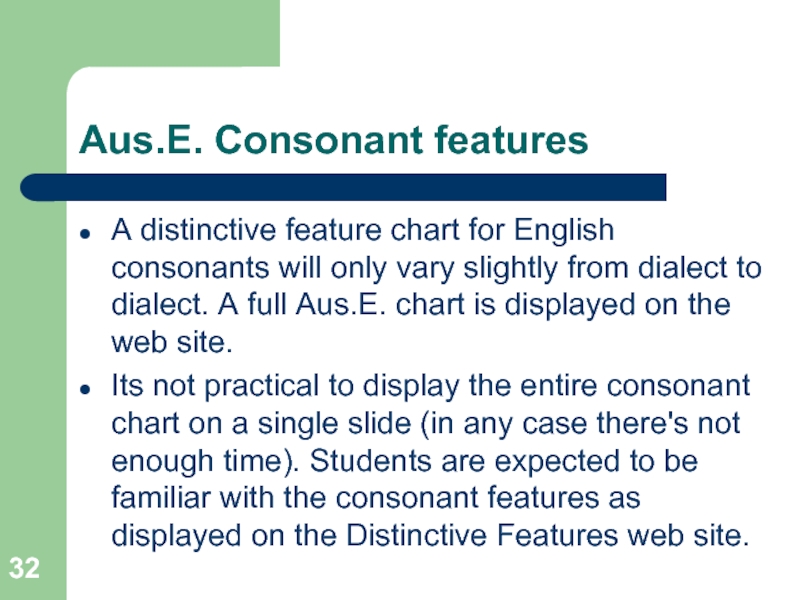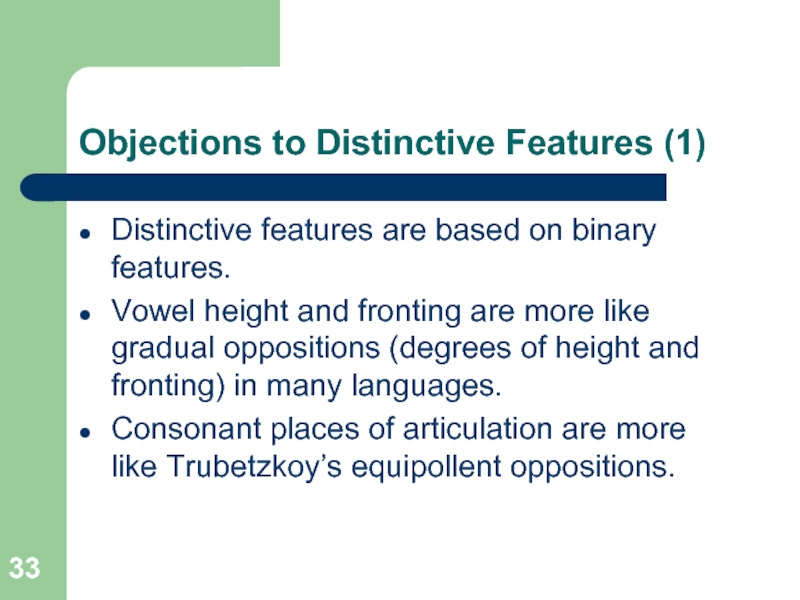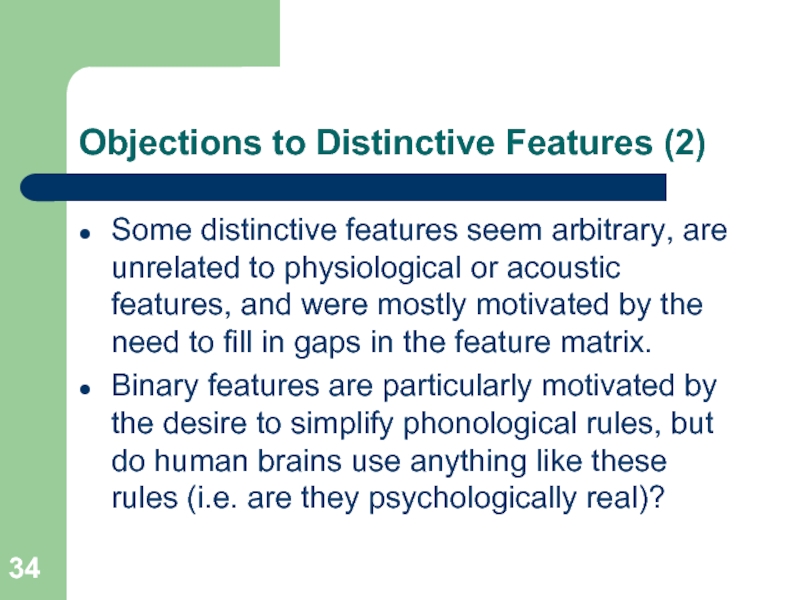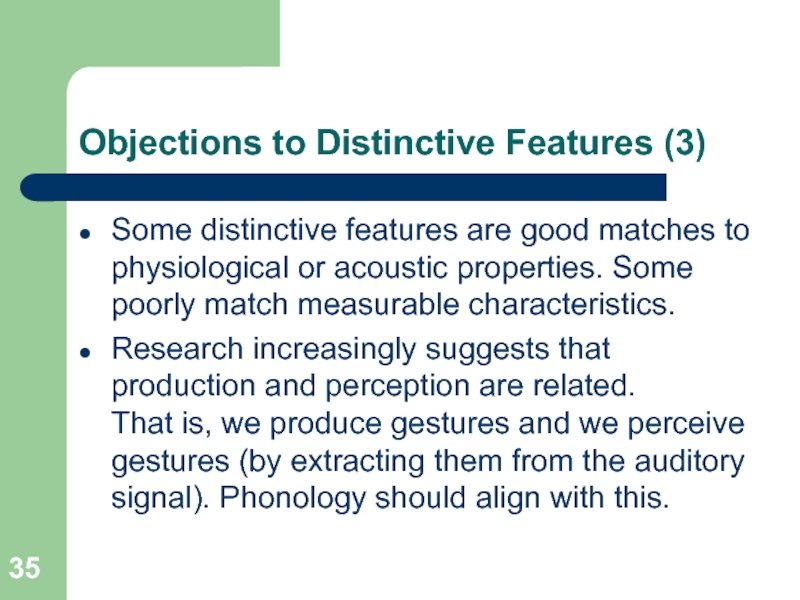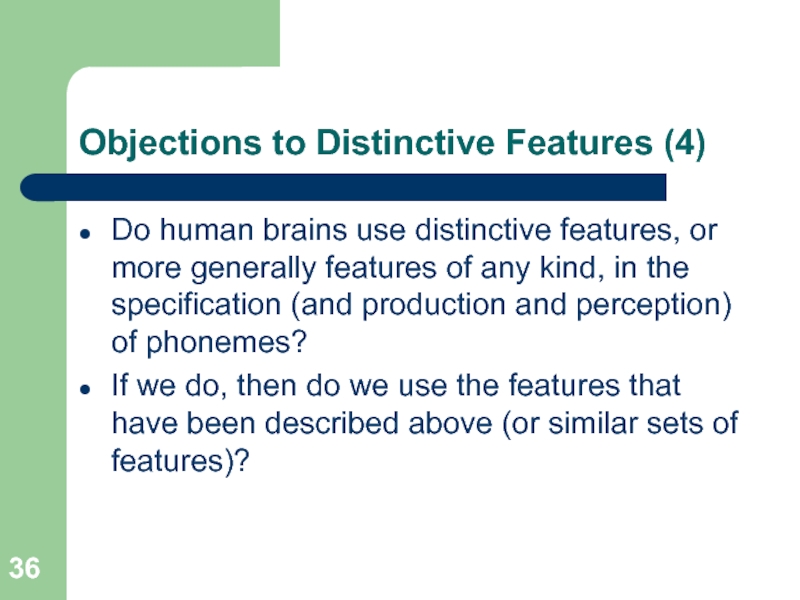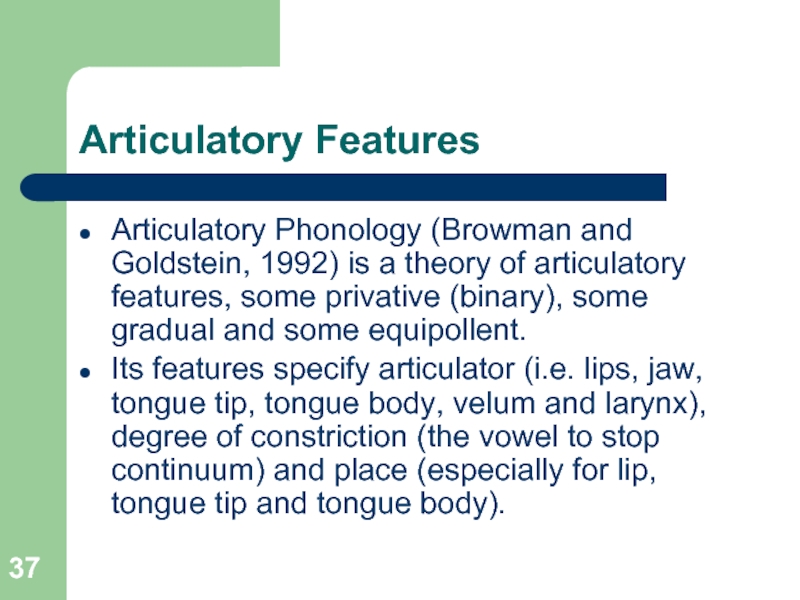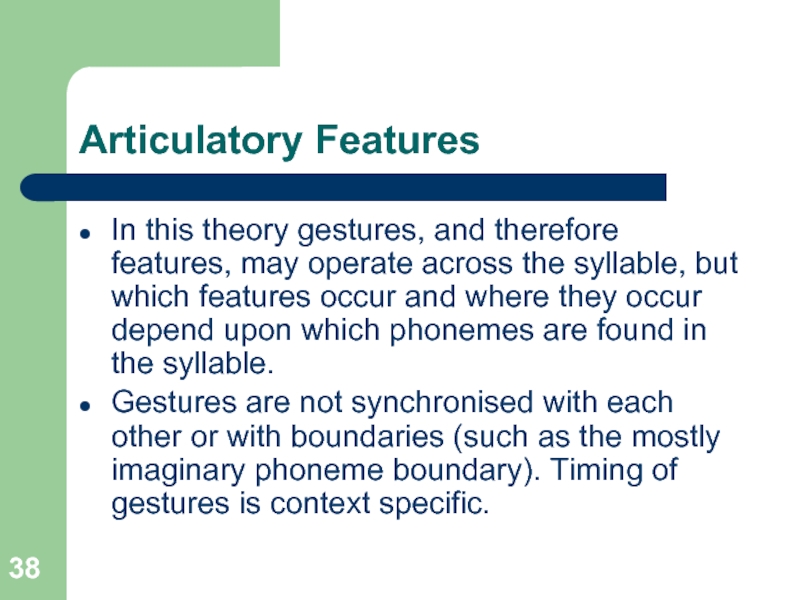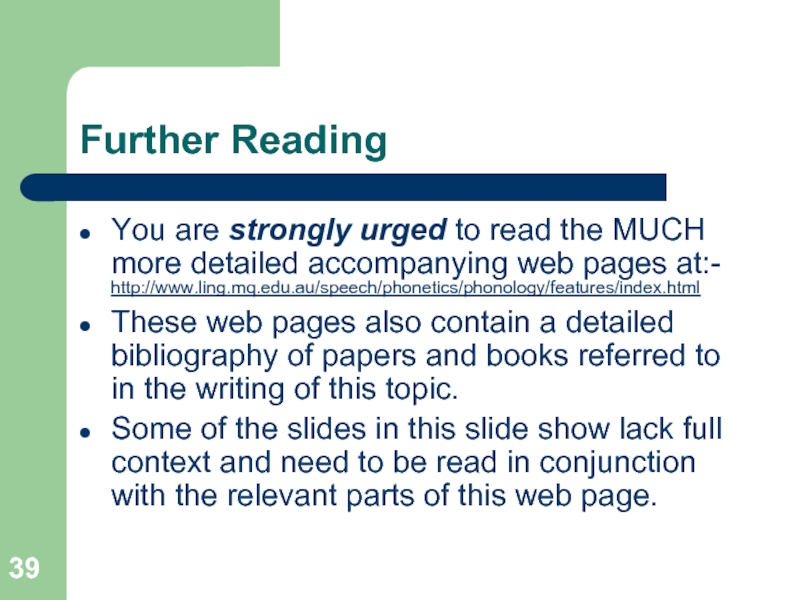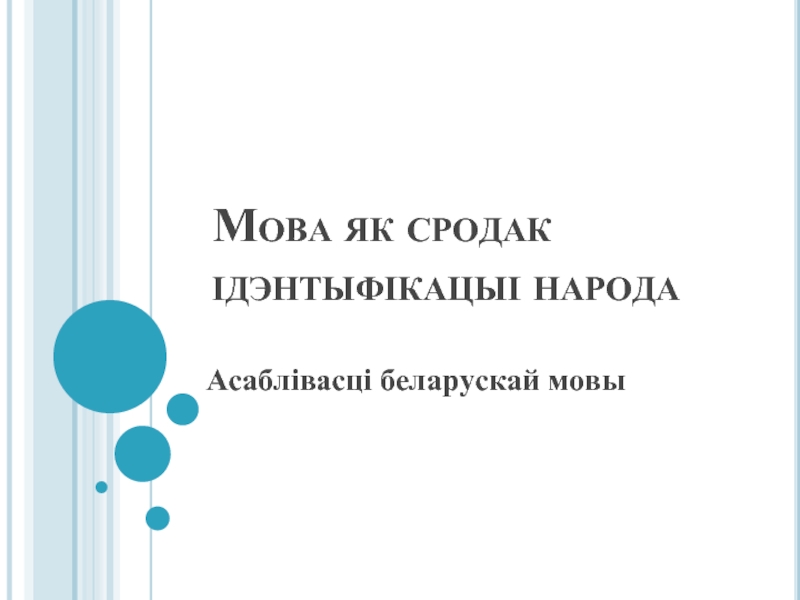- Главная
- Разное
- Дизайн
- Бизнес и предпринимательство
- Аналитика
- Образование
- Развлечения
- Красота и здоровье
- Финансы
- Государство
- Путешествия
- Спорт
- Недвижимость
- Армия
- Графика
- Культурология
- Еда и кулинария
- Лингвистика
- Английский язык
- Астрономия
- Алгебра
- Биология
- География
- Детские презентации
- Информатика
- История
- Литература
- Маркетинг
- Математика
- Медицина
- Менеджмент
- Музыка
- МХК
- Немецкий язык
- ОБЖ
- Обществознание
- Окружающий мир
- Педагогика
- Русский язык
- Технология
- Физика
- Философия
- Химия
- Шаблоны, картинки для презентаций
- Экология
- Экономика
- Юриспруденция
Distinctive Features презентация
Содержание
- 1. Distinctive Features
- 2. Introduction So far we have mainly examined
- 3. Ferdinand de Saussure (1) A word has
- 4. Ferdinand de Saussure (2) Saussure referred to
- 5. Ferdinand de Saussure (3) Speech segments (phonemes
- 6. Ferdinand de Saussure (4) There is an
- 7. Nikolai Trubetzkoy (1) Trubetzkoy (1939) made significant
- 8. Nikolai Trubetzkoy (2) Bilateral Oppositions: a set
- 9. Nikolai Trubetzkoy (3) Privative (binary) Oppositions: A
- 10. Nikolai Trubetzkoy (4) Gradual Oppositions: A class
- 11. Nikolai Trubetzkoy (4) Equipollent oppositions, such as
- 12. Roman Jakobson (1) Roman Jokobson and his
- 13. Roman Jakobson (2) The most important decision
- 14. Roman Jakobson (3) The reason for choosing
- 15. Roman Jakobson (4) Phonological features are expressed
- 16. Chomsky and Halle (1) Chomsky and Halle,
- 17. Chomsky and Halle (2) In their system,
- 18. Chomsky and Halle (3) Distinctive features can
- 19. Chomsky and Halle (4) Over the next
- 20. Major Class Features (1) The following distinctive
- 21. Major Class Features (2) Sonorant [son] -
- 22. Major Class Features (3) Delayed release [delrel]
- 23. Major Class Features (4) Major class distinctive features for English
- 24. Major Class Features (5) To the previous
- 25. Major Class Features (6) Aspirated and unaspirated
- 26. Aus.E. Vowel Features (1) The main vowel
- 27. Aus.E. Vowel Features (2) Two vowel height
- 28. Aus.E. Vowel Features (3) In the following
- 29. Aus.E. Vowel features (3) Vowel features for
- 30. Aus.E. Vowel features (4) I propose an
- 31. Aus.E. Vowel features (5) This table classifies
- 32. Aus.E. Consonant features A distinctive feature chart
- 33. Objections to Distinctive Features (1) Distinctive features
- 34. Objections to Distinctive Features (2) Some distinctive
- 35. Objections to Distinctive Features (3) Some distinctive
- 36. Objections to Distinctive Features (4) Do human
- 37. Articulatory Features Articulatory Phonology (Browman and Goldstein,
- 38. Articulatory Features In this theory gestures, and
- 39. Further Reading You are strongly urged to
Слайд 2Introduction
So far we have mainly examined phonological units at or above
the level of the phoneme.
Some phonological properties of a language are best explained if we posit the existence of phonological units below the phoneme.
We call such units features.
There has been considerable development of this idea over the past 60 years.
Some phonological properties of a language are best explained if we posit the existence of phonological units below the phoneme.
We call such units features.
There has been considerable development of this idea over the past 60 years.
Слайд 3Ferdinand de Saussure (1)
A word has two very different components which
Saussure (1916) referred to as its “form” and its “substance”.
The “substance” of a word are its phonemes, its graphemes (written symbols) and its morphology (how it combines with other morphemes e.g. dog+s).
The “form” of a word is an abstract formal set of relations. That is, it’s our concept of what the word refers to.
The “substance” of a word are its phonemes, its graphemes (written symbols) and its morphology (how it combines with other morphemes e.g. dog+s).
The “form” of a word is an abstract formal set of relations. That is, it’s our concept of what the word refers to.
Слайд 4Ferdinand de Saussure (2)
Saussure referred to the “substance” of a word
as a “signifier” and a word’s “form” as that which is “signified”.
For example, the word “dog” is a signifier. It signifies our concept of what a dog is, rather than an actual dog. This concept of dog is the “signified” referred to by the word “dog”.
The word is the union of signified and signifier.
For example, the word “dog” is a signifier. It signifies our concept of what a dog is, rather than an actual dog. This concept of dog is the “signified” referred to by the word “dog”.
The word is the union of signified and signifier.
Слайд 5Ferdinand de Saussure (3)
Speech segments (phonemes and their allophones) have no
meaning in themselves.
They combine to produce the “form” of a word.
Phonemes have rules for how they combine. (i.e. phonotactic rules)
Meaningless elements (phonemes) combine to form meaningful entities (words).
They combine to produce the “form” of a word.
Phonemes have rules for how they combine. (i.e. phonotactic rules)
Meaningless elements (phonemes) combine to form meaningful entities (words).
Слайд 6Ferdinand de Saussure (4)
There is an arbitrary relationship between the meaningless
and the meaningful.
You can’t determine a word’s meaning from its sounds.
Even onomatopoeic words (where a word mimics the sound of the thing it names) vary greatly from language to language according to each language’s phonology.
You can’t determine a word’s meaning from its sounds.
Even onomatopoeic words (where a word mimics the sound of the thing it names) vary greatly from language to language according to each language’s phonology.
Слайд 7Nikolai Trubetzkoy (1)
Trubetzkoy (1939) made significant contributions to phonology and amongst
them is his typology of phonological “oppositions”.
We will only examine oppositions that are of relevance to the definition of phonological features.
We will only examine oppositions that are of relevance to the definition of phonological features.
Слайд 8Nikolai Trubetzkoy (2)
Bilateral Oppositions: a set of 2 sounds that share
a set of features. e.g. /p,f/ is the set of sounds that are “voiceless labial obstruents” and no other sounds share just these features.
Multilateral Oppositions: a set of more than 2 sounds that share a set of features . e.g. /p,b,f,v/ are “labial obstruents”.
Multilateral Oppositions: a set of more than 2 sounds that share a set of features . e.g. /p,b,f,v/ are “labial obstruents”.
Слайд 9Nikolai Trubetzkoy (3)
Privative (binary) Oppositions: A member of a pair of
sounds possesses a feature which the other lacks. They share all other features and that set of features is shared with no other sound. e.g. /f,v/ are labial obstruents. /v/ possess the feature [voice], /f/ doesn’t.
In this case /v/ is said to be “marked” (it has the feature) and /f/ is “unmarked”.
In this case /v/ is said to be “marked” (it has the feature) and /f/ is “unmarked”.
Слайд 10Nikolai Trubetzkoy (4)
Gradual Oppositions: A class of sounds that possess different
degrees or gradations of a feature or property. e.g. /I, e, {/ are short front vowels with different degrees of height.
Equipollent Oppositions: A class of sounds possess the same features except that they differ according to values of a feature that are logically equivalent. e.g. /s,S/ have identical features except for place of articulation.
Equipollent Oppositions: A class of sounds possess the same features except that they differ according to values of a feature that are logically equivalent. e.g. /s,S/ have identical features except for place of articulation.
Слайд 11Nikolai Trubetzkoy (4)
Equipollent oppositions, such as the different places of articulation
are logically equivalent because no place of articulation can be said to be the absence of another place of articulation (e.g. [+post-alveolar] is not in any sense the same as [-alveolar] or vice versa)
Note that [+feature] means the presence of a feature and [-feature] its absence.
Note that [+feature] means the presence of a feature and [-feature] its absence.
Слайд 12Roman Jakobson (1)
Roman Jokobson and his colleagues (over the period 1941-1956)
contributed extensively to the development of distinctive feature theory.
He made some choices about how to describe phonological features that would dominate feature theory for 40 or more years.
He made some choices about how to describe phonological features that would dominate feature theory for 40 or more years.
Слайд 13Roman Jakobson (2)
The most important decision he made was the assertion
that ALL phonological features are binary. That is a phoneme either possesses a feature or it doesn’t.
This means that features easily expressed as gradual oppositions (e.g. vowel height) or equipollent oppositions (e.g. consonant place of articulation) needed to be expressed (often clumsily) as a set of binary features.
This means that features easily expressed as gradual oppositions (e.g. vowel height) or equipollent oppositions (e.g. consonant place of articulation) needed to be expressed (often clumsily) as a set of binary features.
Слайд 14Roman Jakobson (3)
The reason for choosing binary features was that they
made phonological rules easier to express. e.g. if X then [+B] else [-B]
Jakobsen asserted that a small set of features can differentiate between the phonemes of any language.
Jakobsen asserted that a small set of features can differentiate between the phonemes of any language.
Слайд 15Roman Jakobson (4)
Phonological features are expressed in terms of phonetic (acoustic
and articulatory) features.
Phonetic features are surface realisations of underlying phonological features.
A phonological feature may be realised by more than one phonetic feature.
Phonetic features are surface realisations of underlying phonological features.
A phonological feature may be realised by more than one phonetic feature.
Слайд 16Chomsky and Halle (1)
Chomsky and Halle, in their 1968 book Sound
Pattern of English, developed Jakobson’s features and incorporated them into the system of Generative phonology.
Subsequent modifications, including those by Halle, Ladefoged, Fant, Stevens, Clements and Keyser changed and added to the original set of features.
Subsequent modifications, including those by Halle, Ladefoged, Fant, Stevens, Clements and Keyser changed and added to the original set of features.
Слайд 17Chomsky and Halle (2)
In their system, features are always binary and
are chosen for their ability to be expressed in phonological rules (rules are a prominent feature of generative phonology).
Features can be used to express natural classes of sounds. Additional features can then be used to distinguish the individual phonemes.
Features can be used to express natural classes of sounds. Additional features can then be used to distinguish the individual phonemes.
Слайд 18Chomsky and Halle (3)
Distinctive features can be expressed in terms of
articulatory correlates. They moved away from Jakobson’s and Fant’s use of acoustics features.
Gradually features became increasingly abstract and physiological justification (i.e. the expression of clear articulatory correlates) was weakened.
Gradually features became increasingly abstract and physiological justification (i.e. the expression of clear articulatory correlates) was weakened.
Слайд 19Chomsky and Halle (4)
Over the next few pages we will examine
what mostly consists of the distinctive features as expressed by Halle and Clements (1983).
I have made some modifications (deletions, additions and substitutions) to their set of features and these changes are explained on the web site (see the Further Reading page at the end of this slide show for details).
I have made some modifications (deletions, additions and substitutions) to their set of features and these changes are explained on the web site (see the Further Reading page at the end of this slide show for details).
Слайд 20Major Class Features (1)
The following distinctive features can be used to
discriminate the major phonetic classes in English.
Syllabic [syll] - able to act as the nucleus of a syllable (vowels and syllabic consonants)
Consonantal [cons] - characterising all consonants except semi-vowels [w,j]
Syllabic [syll] - able to act as the nucleus of a syllable (vowels and syllabic consonants)
Consonantal [cons] - characterising all consonants except semi-vowels [w,j]
Слайд 21Major Class Features (2)
Sonorant [son] - originally defined acoustically as possessing
low frequency voiced energy.
i.e. vowels, nasal stops and semi-vowels and liquids (nb. liquids [l,R] and semi-vowels [w,j] are sub-classes of approximant)
Continuant [cont] - continuous airflow through the oral cavity (vowels, fricatives, liquids and semi-vowels)
Continuant [cont] - continuous airflow through the oral cavity (vowels, fricatives, liquids and semi-vowels)
Слайд 22Major Class Features (3)
Delayed release [delrel] an extra long stop release.
It indicates affrication and separates oral stops from affricates.
On the next page we see a typical feature matrix. “+” means the sounds have the feature and “-” means that they don’t. “0” means the feature is irrelevant or is unspecified for that class of sounds.
On the next page we see a typical feature matrix. “+” means the sounds have the feature and “-” means that they don’t. “0” means the feature is irrelevant or is unspecified for that class of sounds.
Слайд 24Major Class Features (5)
To the previous table we could have added
“nasal” [nas]. It would nave been redundant in this table as oral and nasal stops are already distinguished by [son], but the [nasal] feature is also required to distinguish oral versus nasalised vowels and approximants.
Слайд 25Major Class Features (6)
Aspirated and unaspirated stops are separated by a
[spread glottis] feature. This simply means the glottis remains open (preventing voicing) for a significant time following the stop release.
A “sibilant” [sib] feature is added to separate sibilant fricatives [s,z,S,Z] from the other fricatives and also includes the English affricates.
A “sibilant” [sib] feature is added to separate sibilant fricatives [s,z,S,Z] from the other fricatives and also includes the English affricates.
Слайд 26Aus.E. Vowel Features (1)
The main vowel feature “syllabic” [syll] is unique
to vowels and distinguishes them from otherwise very similar semi-vowels
(e.g. [i ~ j] and [u ~ w])
Halle and Clements allow three height features to distinguish up to 4 levels of height. Only as many of these as are needed are used for any individual language.
Halle and Clements allow three height features to distinguish up to 4 levels of height. Only as many of these as are needed are used for any individual language.
Слайд 27Aus.E. Vowel Features (2)
Two vowel height systems (1 feature):-
high [+high], low
[-high]
Three vowel height systems (2 features):- high [+high -low], mid [-high -low], low [-high +low]
Four vowel height systems (3 features):- high [+high -mid -low], mid-high [+high +mid -low] mid-low [-high +mid +low], low [-high -mid +low]
Three vowel height systems (2 features):- high [+high -low], mid [-high -low], low [-high +low]
Four vowel height systems (3 features):- high [+high -mid -low], mid-high [+high +mid -low] mid-low [-high +mid +low], low [-high -mid +low]
Слайд 28Aus.E. Vowel Features (3)
In the following table of Australian English monophthong
vowel features:-
[+tense] is long and [-tense] is short.
I’ve added an extra fronting feature [front] to distinguish 3 degree of fronting (the original set assumes a maximal system of two levels of fronting). Central vowels are [-front -back] I could have used the consonant feature anterior, but this is quite different involving tongue tip and lips rather than tongue body
[+tense] is long and [-tense] is short.
I’ve added an extra fronting feature [front] to distinguish 3 degree of fronting (the original set assumes a maximal system of two levels of fronting). Central vowels are [-front -back] I could have used the consonant feature anterior, but this is quite different involving tongue tip and lips rather than tongue body
Слайд 29Aus.E. Vowel features (3)
Vowel features for Australian English monophthong vowels.
Schwa is
(“0”) unspecified for all of these features but has all vowel class features (see above).
Слайд 30Aus.E. Vowel features (4)
I propose an extra vowel feature [onglide] to
deal with the distinction between /i: I@ I/ in Australian English. The vowel /i:/ is characterised by an onglide.
All three are [+high -low +front -back -round]
All three are [+high -low +front -back -round]
Australian English high front vowels
Слайд 31Aus.E. Vowel features (5)
This table classifies height [high/low] and fronting [front/back]
according to the first target’s features. [+round] is selected if either target is rounded.
All diphthongs are long [+tense] and all have an offglide (that may or may not have a clear target).
Australian
English
Diphthongs
Слайд 32Aus.E. Consonant features
A distinctive feature chart for English consonants will only
vary slightly from dialect to dialect. A full Aus.E. chart is displayed on the web site.
Its not practical to display the entire consonant chart on a single slide (in any case there's not enough time). Students are expected to be familiar with the consonant features as displayed on the Distinctive Features web site.
Its not practical to display the entire consonant chart on a single slide (in any case there's not enough time). Students are expected to be familiar with the consonant features as displayed on the Distinctive Features web site.
Слайд 33Objections to Distinctive Features (1)
Distinctive features are based on binary features.
Vowel height and fronting are more like gradual oppositions (degrees of height and fronting) in many languages.
Consonant places of articulation are more like Trubetzkoy’s equipollent oppositions.
Слайд 34Objections to Distinctive Features (2)
Some distinctive features seem arbitrary, are unrelated
to physiological or acoustic features, and were mostly motivated by the need to fill in gaps in the feature matrix.
Binary features are particularly motivated by the desire to simplify phonological rules, but do human brains use anything like these rules (i.e. are they psychologically real)?
Binary features are particularly motivated by the desire to simplify phonological rules, but do human brains use anything like these rules (i.e. are they psychologically real)?
Слайд 35Objections to Distinctive Features (3)
Some distinctive features are good matches to
physiological or acoustic properties. Some poorly match measurable characteristics.
Research increasingly suggests that production and perception are related. That is, we produce gestures and we perceive gestures (by extracting them from the auditory signal). Phonology should align with this.
Research increasingly suggests that production and perception are related. That is, we produce gestures and we perceive gestures (by extracting them from the auditory signal). Phonology should align with this.
Слайд 36Objections to Distinctive Features (4)
Do human brains use distinctive features, or
more generally features of any kind, in the specification (and production and perception) of phonemes?
If we do, then do we use the features that have been described above (or similar sets of features)?
If we do, then do we use the features that have been described above (or similar sets of features)?
Слайд 37Articulatory Features
Articulatory Phonology (Browman and Goldstein, 1992) is a theory of
articulatory features, some privative (binary), some gradual and some equipollent.
Its features specify articulator (i.e. lips, jaw, tongue tip, tongue body, velum and larynx), degree of constriction (the vowel to stop continuum) and place (especially for lip, tongue tip and tongue body).
Its features specify articulator (i.e. lips, jaw, tongue tip, tongue body, velum and larynx), degree of constriction (the vowel to stop continuum) and place (especially for lip, tongue tip and tongue body).
Слайд 38Articulatory Features
In this theory gestures, and therefore features, may operate across
the syllable, but which features occur and where they occur depend upon which phonemes are found in the syllable.
Gestures are not synchronised with each other or with boundaries (such as the mostly imaginary phoneme boundary). Timing of gestures is context specific.
Gestures are not synchronised with each other or with boundaries (such as the mostly imaginary phoneme boundary). Timing of gestures is context specific.
Слайд 39Further Reading
You are strongly urged to read the MUCH more detailed
accompanying web pages at:-
http://www.ling.mq.edu.au/speech/phonetics/phonology/features/index.html
These web pages also contain a detailed bibliography of papers and books referred to in the writing of this topic.
Some of the slides in this slide show lack full context and need to be read in conjunction with the relevant parts of this web page.
These web pages also contain a detailed bibliography of papers and books referred to in the writing of this topic.
Some of the slides in this slide show lack full context and need to be read in conjunction with the relevant parts of this web page.
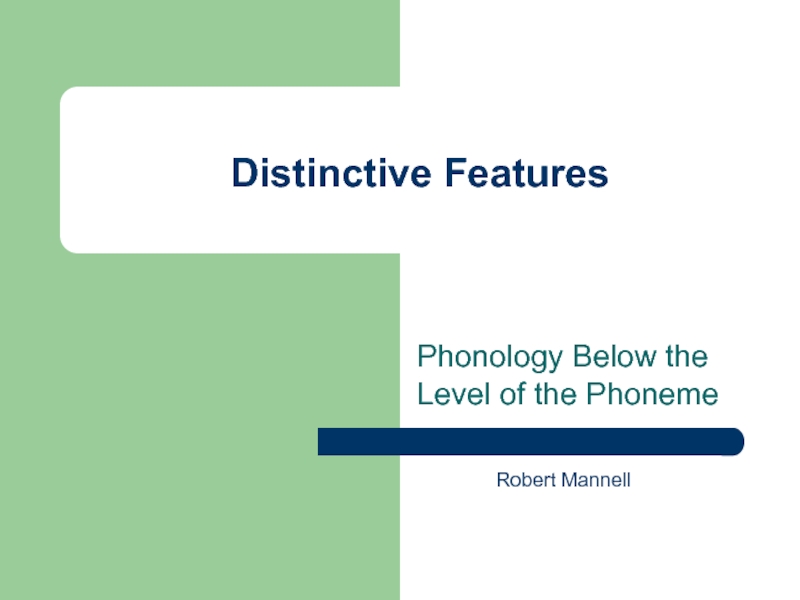
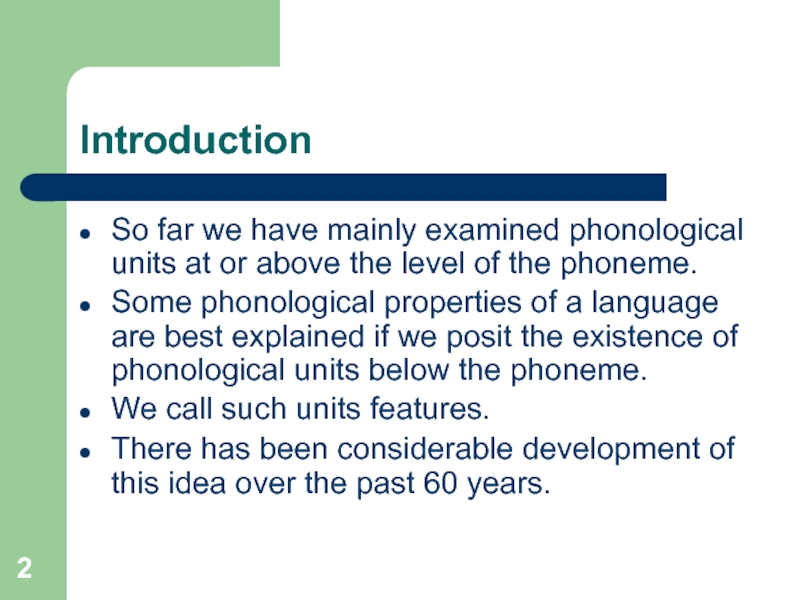
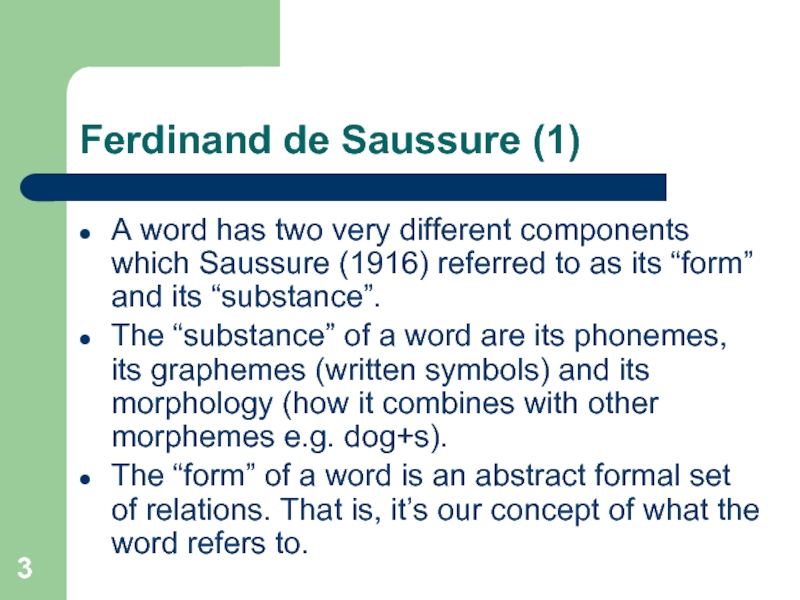
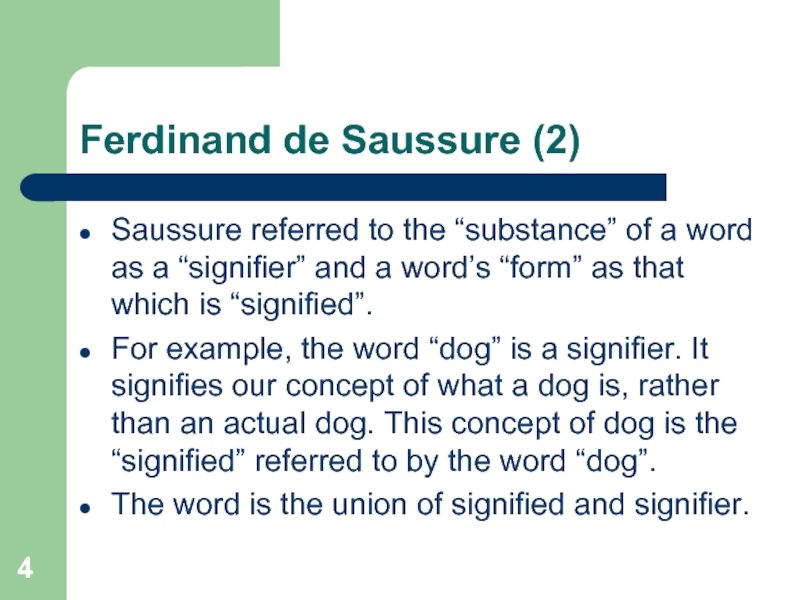
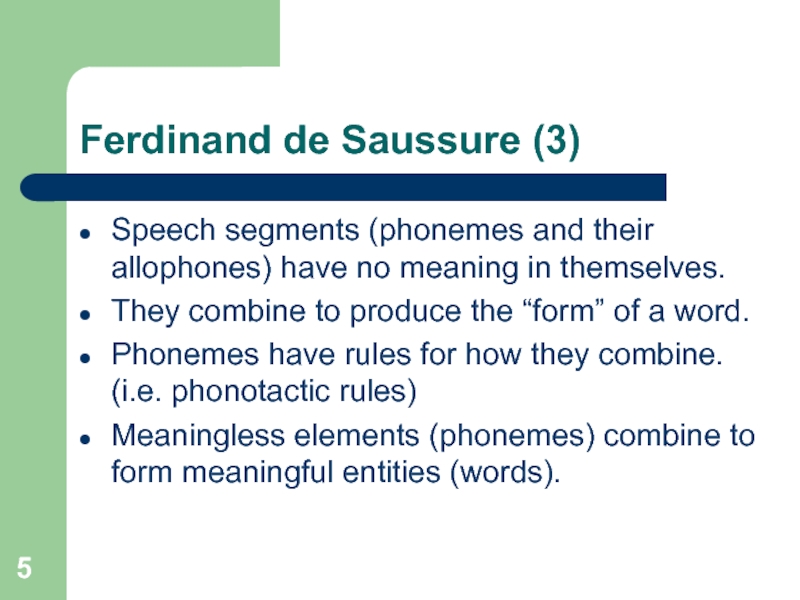
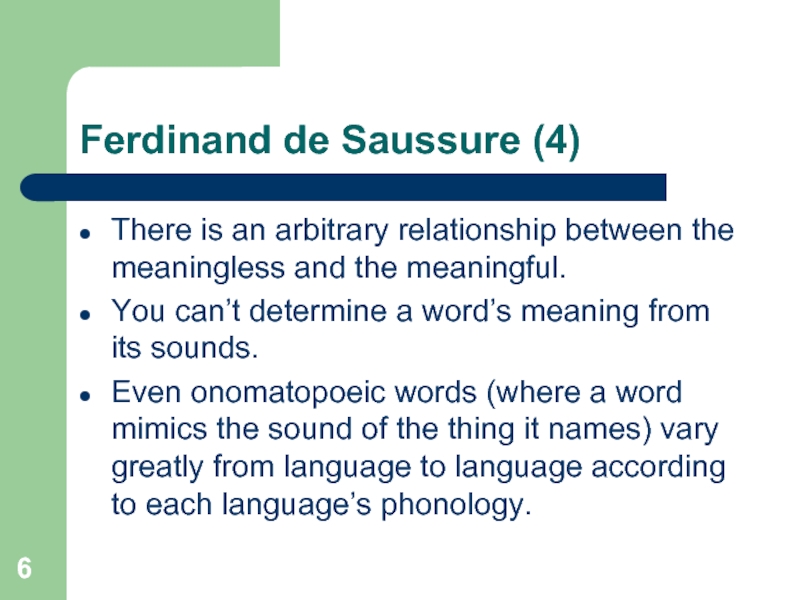
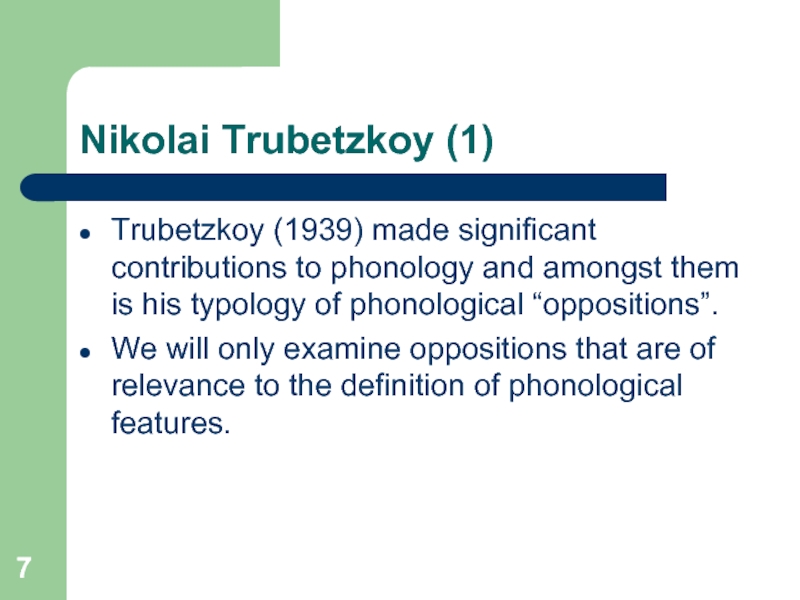
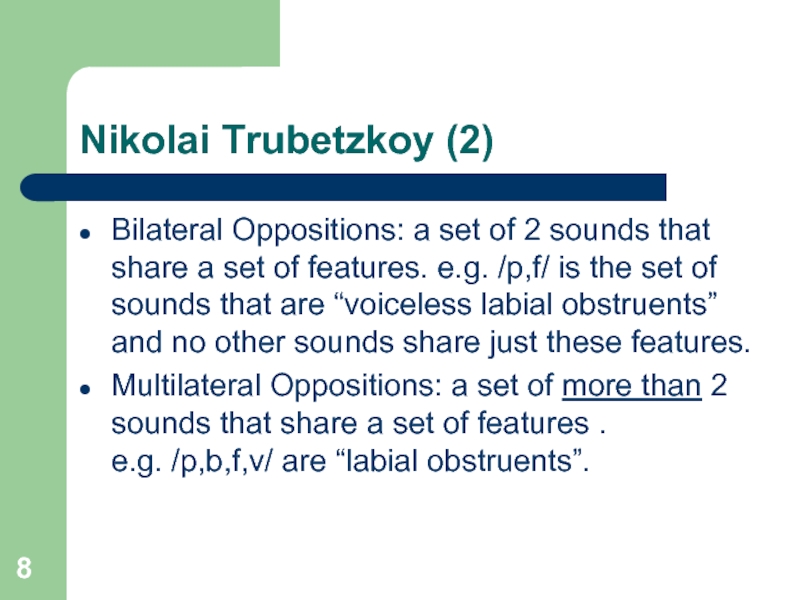
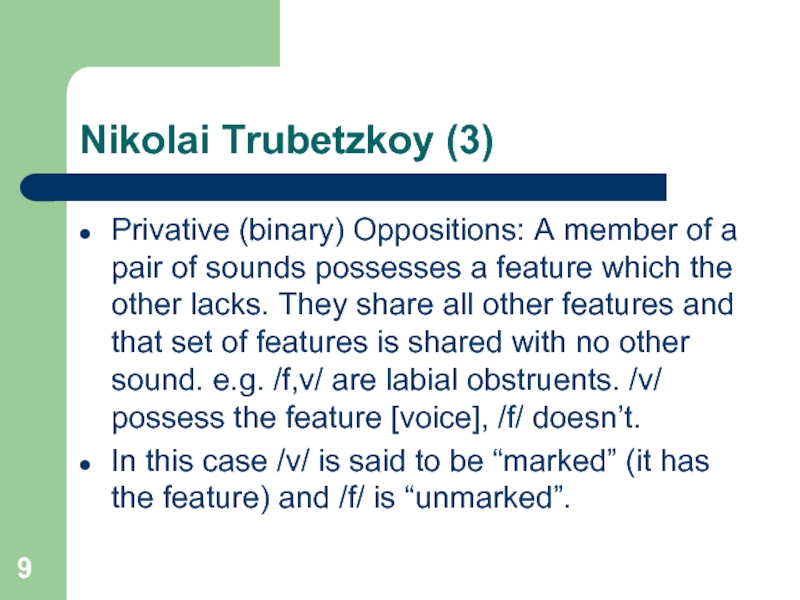
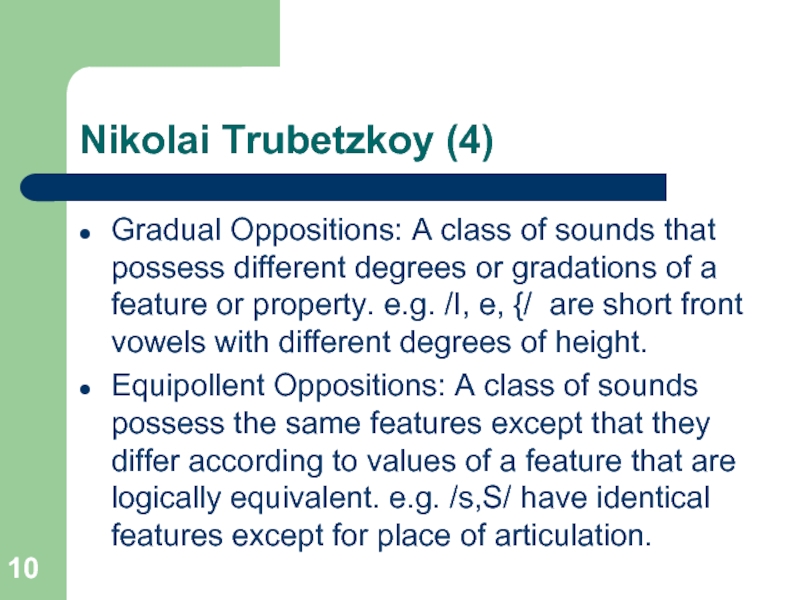
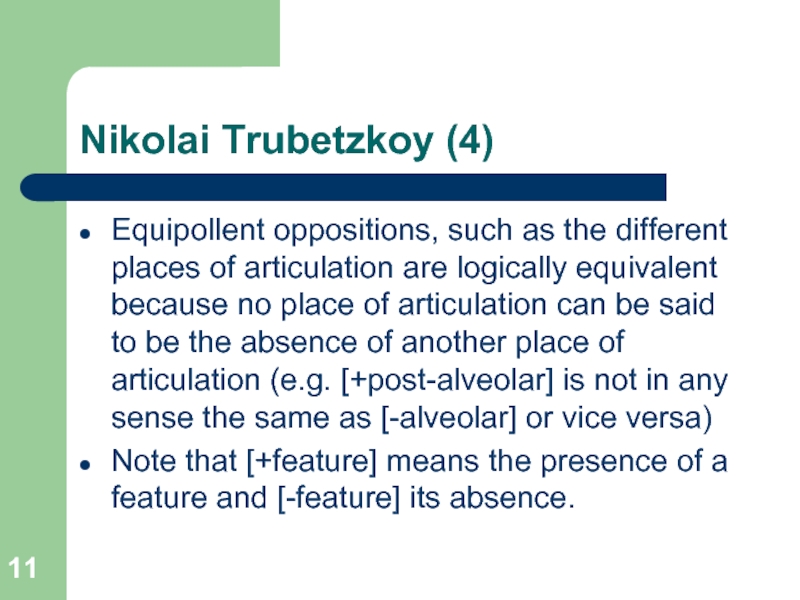
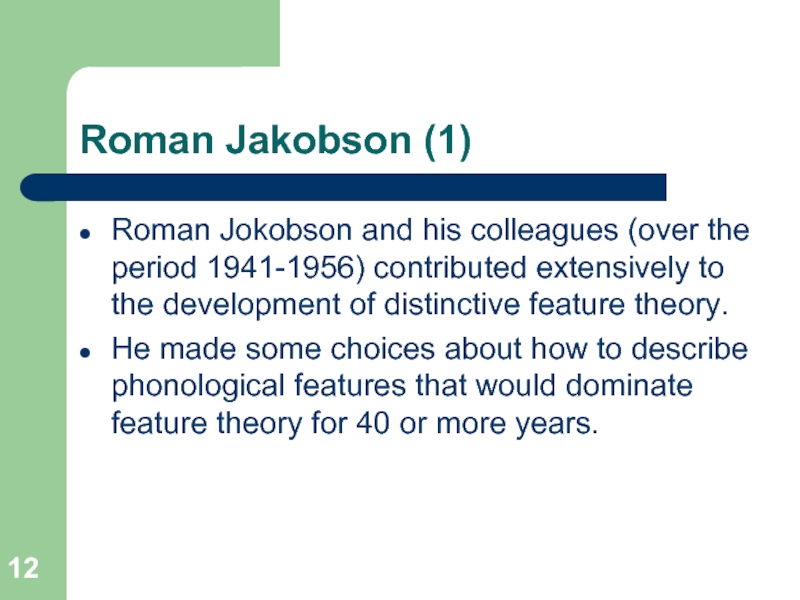
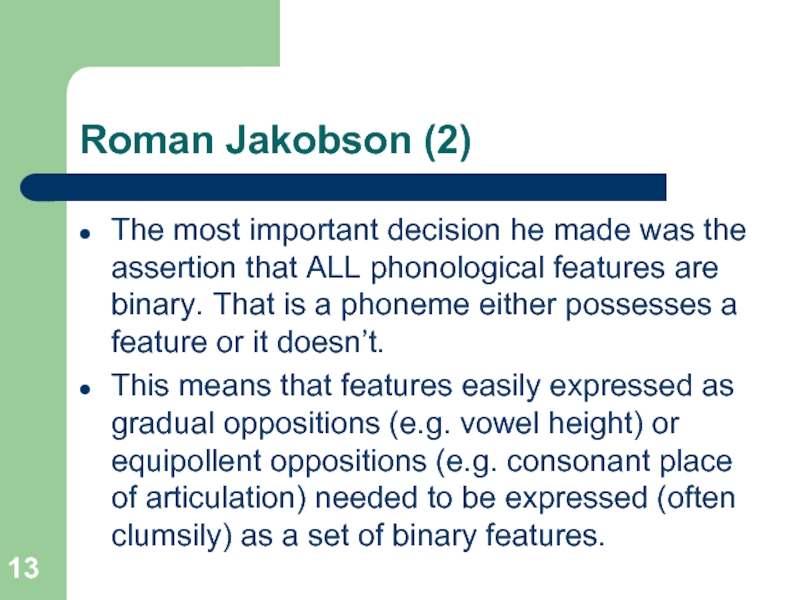
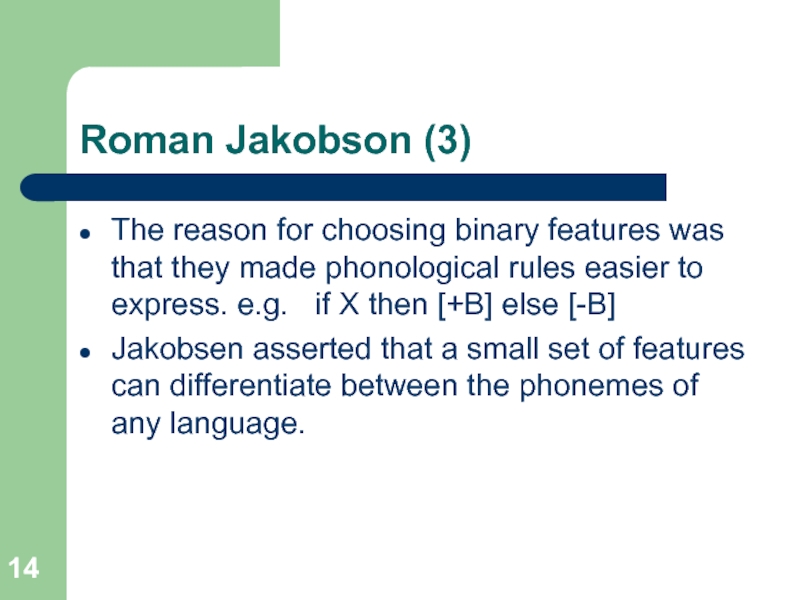
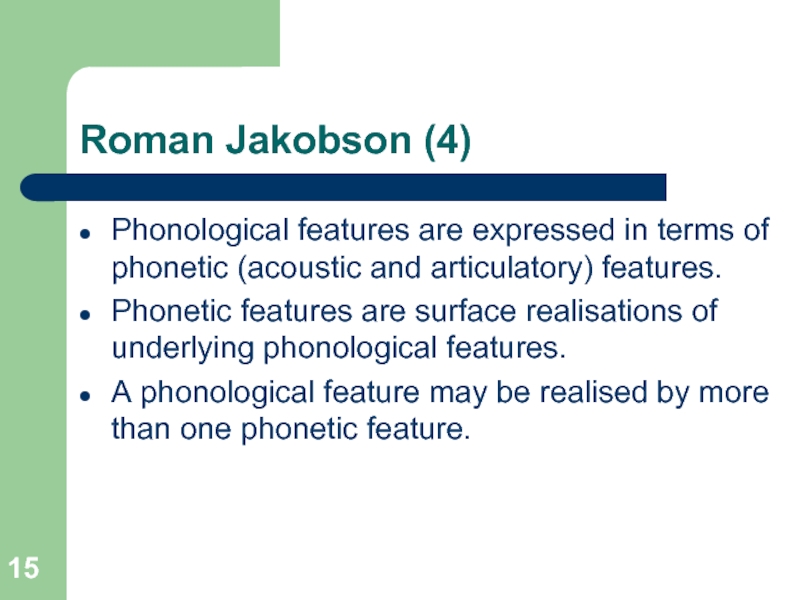

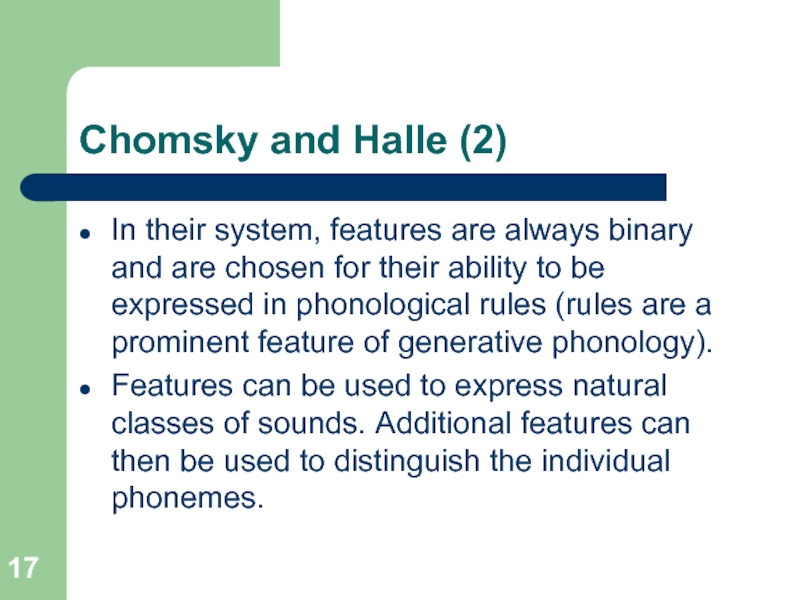
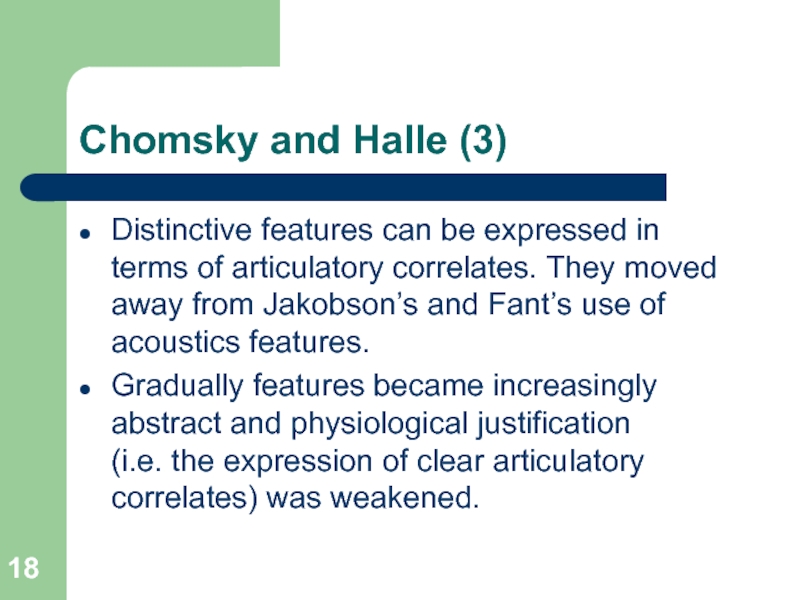
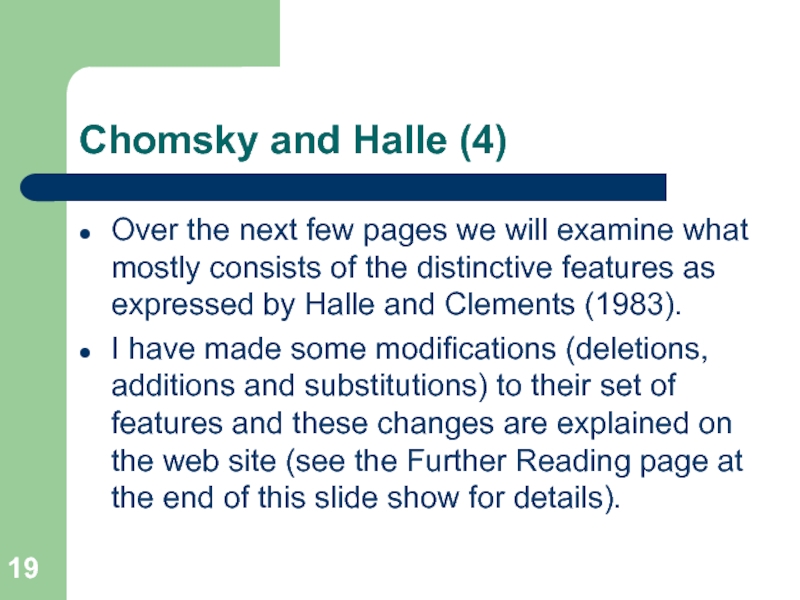
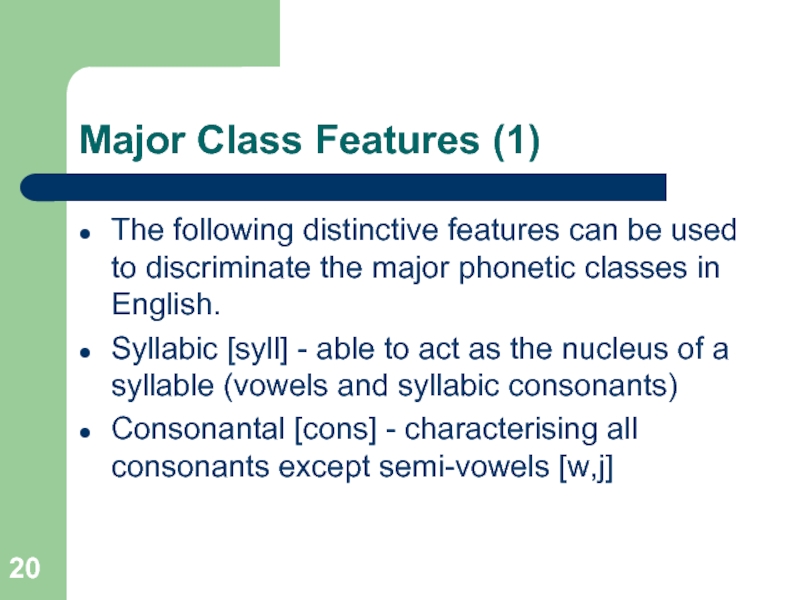
![Major Class Features (2)Sonorant [son] - originally defined acoustically as possessing low frequency voiced energy.](/img/tmb/1/28377/99b0d6ab33cf7931b19644c17871938a-800x.jpg)
![Major Class Features (3)Delayed release [delrel] an extra long stop release. It indicates affrication and](/img/tmb/1/28377/526a20a7d99f62a75b629b0f23fd530e-800x.jpg)
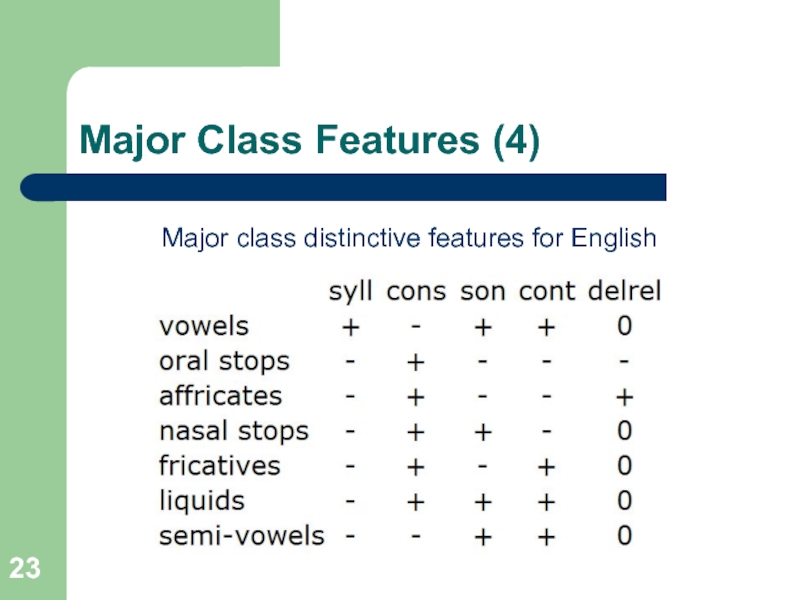
![Major Class Features (5)To the previous table we could have added “nasal” [nas]. It would](/img/tmb/1/28377/3225a2ddc40565a94261ef72bae19a4d-800x.jpg)
![Major Class Features (6)Aspirated and unaspirated stops are separated by a [spread glottis] feature. This](/img/tmb/1/28377/c9dbbc8a697ff28726828f969063dca1-800x.jpg)
![Aus.E. Vowel Features (1)The main vowel feature “syllabic” [syll] is unique to vowels and distinguishes](/img/tmb/1/28377/36ca9322dc6926518c6b579f46d2e7c2-800x.jpg)
![Aus.E. Vowel Features (2)Two vowel height systems (1 feature):- high [+high], low [-high]Three vowel height](/img/tmb/1/28377/20e80e557ac87f24eaf99afaa865f653-800x.jpg)
![Aus.E. Vowel Features (3)In the following table of Australian English monophthong vowel features:-[+tense] is long](/img/tmb/1/28377/39283e49412be713eaad9b11100b0c38-800x.jpg)
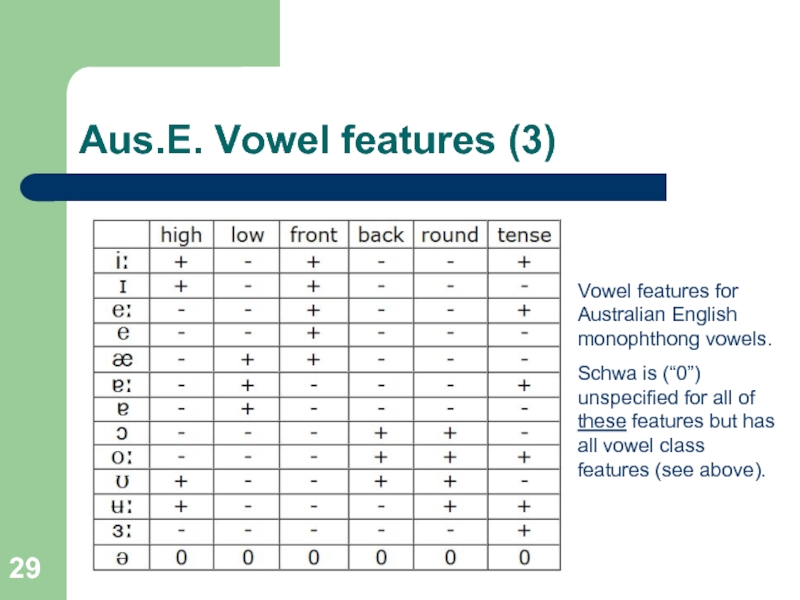
![Aus.E. Vowel features (4)I propose an extra vowel feature [onglide] to deal with the distinction](/img/tmb/1/28377/c3030307d86c120ac2fdd54db36f8b4b-800x.jpg)
![Aus.E. Vowel features (5)This table classifies height [high/low] and fronting [front/back] according to the first](/img/tmb/1/28377/2365161e4c757d0ead83cb69f219e6cf-800x.jpg)
